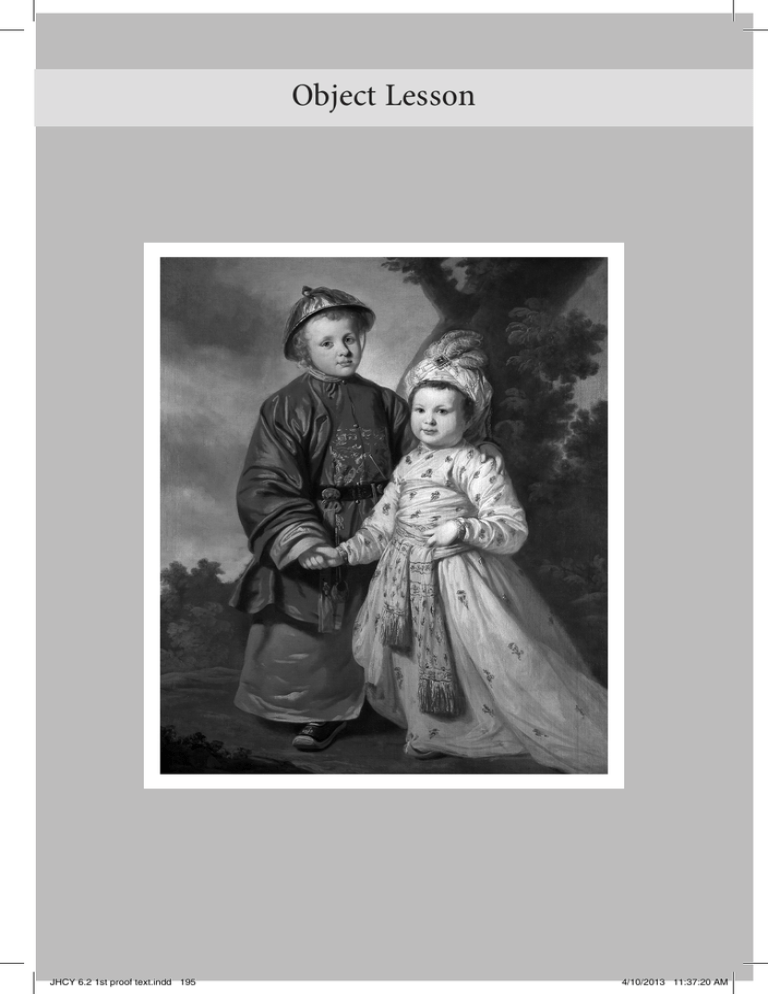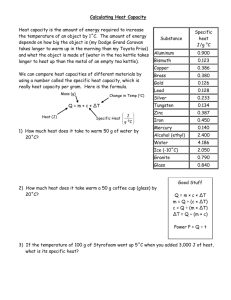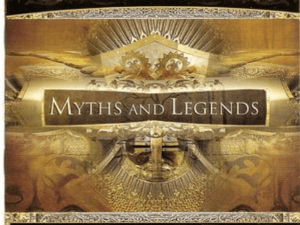Object Lesson JHCY 6.2 1st proof text.indd 195
advertisement

Object Lesson JHCY 6.2 1st proof text.indd 195 4/10/2013 11:37:20 AM Tilly Kettle, Two Children in Asian Clothing, c. 1780–86. 51 x 40 in. Courtesy of the Peabody Essex Museum, Salem JHCY 6.2 1st proof text.indd 196 4/10/2013 11:37:21 AM GIORGIO RIELLO IMPERIAL LIVE S : T WO CHILDREN IN A SIAN CLOTHING he world of the eighteenth century has been described by historians as one of increasing connectedness. The rising power of the European empires—and of the British Empire in particular—secured unprecedented levels of trade and exchange. The trade of the European East India companies in South Asia, for example, entailed the exchange of gifts to ease diplomatic and commercial relations. By the last quarter of the eighteenth century portraits had come to dominate such gift relationships. Dozens of portraits of King George III were sent to India in exchange for which local rulers and princes gifted their own oil portraits. This practice necessitated the services of European painters as largecanvas portraits were an artistic genre absent in Indian art. The first of such European artists to reach India was the Englishman Tilly Kettle (1735–86). To him and another dozen European artists we owe not just a remarkable number of state portraits but also more informal and personal portraits of European East India Company servants and their families living in India. These portraits remind us of the importance of individuals’ lives in shaping larger histories of empire and trade. While the interest for rich Nabobs has been longstanding, historians such as Miles Ogborn, Linda Colley, and Margot Finn have recently claimed the importance of recovering the complexity that personal, family, and collective “micro” stories provide in wider historical frameworks.1 These “life stories” open a series of questions on what Emma Rothschild has termed the “inner life of Empires”: how people shaped the “empire project” and how they negotiated personal, familial, and sentimental ties across vast transoceanic spaces.2 One such case is a portrait of two anonymous children, attributed to Tilly Kettle and recently acquired by the Peabody Essex Museum in Salem, Massachusetts. Behind the loveliness of its subject matter, this double portrait embodies the lives of many who in the eighteenth century inhabited a world that sat between two continents, Europe and Asia. This was a world of Journal of the History of Childhood and Youth (v6.2) © 2013 by The Johns Hopkins University Press JHCY 6.2 1st proof text.indd 197 4/10/2013 11:37:21 AM 198 IMPERIAL LIVES opportunities and the allure of Indian wealth but, as the painting and the artist’s biography show, it was also a world in which what was represented was more a dream than a reality. Both childhood and Asia are sites of illusion. Tilly Kettle was born in London in 1735, the son of a house painter. He was trained in the British capital, and as many other metropolitan artists at the time he was influenced by Reynolds, though he was neither one of his pupils nor one of his most important followers. As a middle-rank artist, he made a name for himself outside London, especially by touring Oxfordshire and the Midlands between 1762 and 1764.3 Although technically gifted, he lacked patronage, those contacts that could have secured him a steady flow of wealthy patrons. This might explain why in his early thirties, he decided to seek his fortune in India. Kettle was a pioneer as, when he reached Madras in 1769, he was the first professional British painter in the subcontinent. He was soon followed by another dozen artists and engravers who reached India before 1785.4 We know little of Kettle’s life in the subcontinent. Later artists were warned by word of mouth about the terrible discomforts including the lack of colors and other materials for painting. Kettle was a neophyte but managed to survive a risky six-month voyage and once in India “those horrid Indian fevers of which I had heard so much during our voyage.”5 One-third of those Europeans who reached India did not survive long. As the first British artist in India, Kettle was the undisputed master of a new portraiture market. He spent the first two years of his seven-year Indian stay in Madras where he received the patronage of the Nawab of Arcot, Muhammad Ali. Later, he moved to Kolcatta, then in British hands, and from Kolcatta to Faizabad where he received the patronage of one of the best-known Indian rulers, Shujaud-daula, Vizier of the Mughal Empire and Nawab of Oudh, here portrayed with his more famous—one might say notorious and extravagant—son, Asafud-daula, and another nine of his children (figure 1).6 This is a peculiar “family portrait” that can be read at three distinct levels. The central figures of Shuja-uddaula and his oldest son Asaf-ud-daula are given prominence, not just by being at the center of the composition, but also by the disproportionate height of both men. Asaf-ud-daula looks at his father, creating a visual connection that is also a line succession to the throne. The remaining sons are nothing more than a background for the central composition: their faces are not very detailed, and with the exception of the second oldest son, standing near his father, the remaining sons are both small and rather flat. Finally, on the left corner Tilly Kettle represents himself in the very act of painting the portrait while wearing a pair of spectacles. His European identity is expressed not just by the wearing of European clothing but also by sitting on a so-called Anglo-Indian chair decorated in ivory. JHCY 6.2 1st proof text.indd 198 4/10/2013 11:37:21 AM Journal of the History of Childhood and Youth 199 Figure 1 Watercolour on paper depicting Tilly Kettle painting a portrait of Shuja ud-Daula and his ten sons, c. 1815 after a presume painting by Tilly Kettle of c. 1772. Courtesy of the Victorial and Albert Museum, London IS.5-1971. In India, Kettle’s customers were not just the local ruling elite. He received good business from Englishmen (most famously Warren Hastings) and their families. While his English patrons were attired like they were out on a country trip and “without a trace of domineering vulgarity”7—a later art historian would comment—Kettle’s Indian patrons enjoyed the painter’s bolder, sometimes quite flourishing style particularly conveyed in his ability to reproduce luxurious textiles, furs and jewelry through unique chromatic intensity. These two strands of Kettle’s Indian production are mixed in Two Children in Asian Clothing. The young sitters are clearly identifiable as Caucasian children (an old description identified them as English, something that one might doubt can ever be ascertained). Their “Oriental dress” is far from unique. There are a number of examples of Europeans “dressed up” in Asian clothing such as the outlandish attire of Sir Robert Shirley, who in the early seventeenth century worked for Shah Abbas of Persia; the no-less-outlandish dress worn by the renowned French traveler Jean Baptiste Tavernier in the second half of the seventeenth century; and the late eighteenth-century portrait by Reynolds of Captain Foote (c. 1761), now at the York Art Gallery in the United Kingdom. Foote’s costume is remarkably similar to the dress worn by the younger sitter, even to the shape of the turban, which, however, is not particularly Indian. The JHCY 6.2 1st proof text.indd 199 4/10/2013 11:37:21 AM 200 IMPERIAL LIVES Indian dress worn by the younger child looks like a cotton jama with gold thread embroidery. It is indeed rather similar to extant examples, the most famous of which is a jama putatively belonging to Tipu Sultan and now in the Victoria and Albert Museum collection (figure 2). The patka (sash) also seems to be made of cotton, probably with silk and gold embroidery. Extant examples point to the fact that this is an elite dress. The dress is complemented by gold bangles, and the turban includes a jewel, made to look like a turban aigrette complete with the usual feather. What is missing are the ropes of pearls attached to such jewels as here worn by Indian rulers, including Tipu Sultan himself.8 It is clear that Kettle found inspiration for this Indian dress both in the north and the south of the subcontinent. The type of garments and the beautiful light embroidered muslin cloth point to the elite dress as worn in the southern parts of India. It was here that Kettle had started his Indian career and where the English sourced many of the calicoes and chintzes for sale in London. Yet the fine fabrics were more likely to have been woven in a place like Dacca in the northeast where the lightest and best embroidered muslin was produced.9 Finally, the model itself might have come from a real-life commission as the boy at the center of the exquisite pencil drawing of the seven young sons of Shujaud-daula by Kettle bears interesting resemblances with the child in Indian dress (figure 3). It is interesting to reflect upon the fact that a young Indian prince is “transposed” into a European child. While clothing and age remain integral to identity, race seems to be a malleable category in Kettle’s artistic production. Several elements make it plausible that Kettle drew from his own encounters in India, though this argument can neither be validated nor totally supported. We must acknowledge, for instance, that the composition is not quite right in terms of draping, suggesting that the painter adopted artistic licence in order to achieve effect rather than precision. The visual juxtaposition between the Indian dress of the younger child and the Chinese attire of the older one was also clearly carefully studied. The older boy is dressed as a Chinese government official with an official’s typical summer hat. What is surprising is the good rendition of Chinese dress by someone like Kettle who never traveled to China. The robe is an approximation of a Chinese official’s outer coat, and both the color and the cut are correct with no shoulder seams. There is some imprecision though, firstly that the rank badge looks like it is embroidered straight onto the robe in gold-laid work. Usually, rank badges were worked separately and then applied to both the front and back of a robe. The belt adds a nice touch to make the painting more interesting, though belts of this type were not worn around such types of garments. His shoes are not the usual black satin boots worn by JHCY 6.2 1st proof text.indd 200 4/10/2013 11:37:21 AM Journal of the History of Childhood and Youth 201 Figure 2 Robe for a man is of the type called a jama, which crosses over the chest and is fastened with ties at the side. This is a particularly elaborate example is patterned with a repeating block-printed floral design. This robe is said to have belonged to Tipu Sultan of Mysore (d. 1799), although there is only anecdotal evidence for this. Courtesy of the Victoria and Albert Museum IIS.8-1968 JHCY 6.2 1st proof text.indd 201 4/10/2013 11:37:21 AM 202 IMPERIAL LIVES Figure 3 Tilly Kettle, Seven young sons of Shuja ud-Daula, Nawab of Oudh (1754–75), wearing long Muslim jamas. Pencil. c. 1772. 11.5 x 16.5 cm. Courtesy of the Victoria and Albert Museum, AL.9260:1 adult officials but are a good rendering of Chinese shoes with wooden soles and embroidered uppers.10 Overall the level of detail suggests that Kettle must have had access to real Chinese clothing, a departure compared to Kettle’s early engagement with a Chinese subject in his portrait of Mrs. Yates as Madane in the opera Orphan of China (1765). Here dress was totally un-Chinese, though the painting included many of the theatrical effects that the artist later used for his Indian portraits.11 Might the dress worn by the two children have a meaning beyond the simple wearing of “exotic” attire? As we do not know who the children are, one might wish to think that they were the sons (one might even say a son and a daughter) of an English East Indianman who served both in India and in China. This is a suggestive but unlikely hypothesis. More probably, the painting was an act of mixing real and fictional, a dressing up, most likely done not in India but in England. Once again, examples of children dressed in “Oriental” clothing are not uncommon. In the early eighteenth century, the well-known Lady Mary Wortley Montague was painted with her son in Eastern dress. This practice continued well into the nineteenth century with some splendid examples like Chinnery’s Kirkpatrick Children (1805), the sons of an East India Company servant, James Achilles Kirkpatrick, and a Muslim noblewoman, Khair um-Nisa.12 JHCY 6.2 1st proof text.indd 202 4/10/2013 11:37:21 AM Journal of the History of Childhood and Youth 203 In this case the dress of the children does express both their father’s business ties to India and their mixed Eurasian parentage. Kettle himself had great practice in portraying families and had already painted brothers as in the case of Charles and Hohn Sealy, a painting of adult brothers dressed in European clothing that he completed in Calcutta in 1773.13 In this painting Charles leans on his brother’s shoulder, creating a sense of intimacy that is replicated in Two Children in Asian Clothing through their hand and body contact. Later, Kettle painted the two daughters of Alexander Davidson, an East India Company servant that he had portrayed in Madras. The two children are again represented in an intimate informal pose, sitting on the floor in an affectionate gesture.14 What are we to make of these children with their intimate, affectionate pose and their elaborate, carefully observed, and yet oddly disparate Asian garb? What might the artist have intended in representing such children in such clothes? Asian dress was not yet rejected by Westerners as it was just a generation after Kettle lived in India.15 Yet this was no ordinary clothing worn by European children in the hot climates of Asia. This painting is instead a representation of power and wealth: children of middle- or upper-class backgrounds being transformed into Indian princes and Chinese officials. The portrait’s subject matter, the very young age of both sitters, might also be less than casual. In an age in which social barriers were emerging against intermarriage, favoring a clear social differentiation between European and the local elites, childhood was used as a device to convey innocence and the unspoiled “exotic” allure of the East. As Natasha Eaton has pointed out, the exotic was defined by its playfulness and its claims to cosmopolitanism.16 Yet it risked to be tarnished by the social critique of Europeans’ eastern decadence (embodied by the Nabob figure) and the accusation of effeminacy. The purity of youth allowed for a morally safe ground in which to position hybrid and invented identities. The grounding of this portrait in its sociocultural milieu might yield a deeper understanding of its subject matter. Another possibility for understanding this painting is to reflect instead on Kettle’s own relation to it. After all, this was a very fitting image of his own family and children, or better to say his two families and four children. During his stay in India Kettle had two daughters with his Indian bibi (consort); the girls were born in 1773 and 1774.17 Such relations were quite common: Zoffany did the same, and so did the famous Swiss adventurer—at the time a servant of the English East India Company—Antoine Polier, who had six children that he took back to Europe together with his Indian consort.18 Unlike Polier, however, Kettle left his family in India. By 1776 he was a wealthy man selling paintings at four to five JHCY 6.2 1st proof text.indd 203 4/10/2013 11:37:22 AM 204 IMPERIAL LIVES thousand rupees, equivalent to £500, an enormous sum if we think that an old master fetched £100. As did many other European men, he might have provided a financial settlement for his Indian consort. Back in London Kettle married Mary Paine, daughter of the architect James Paine, president of the Society of Artists. He had two further children, Mary and James.19 This is a painting of wider geographies and exotic references, but also a painting of intimate family affairs in which, in the case of Kettle, these Caucasian children might have literally stepped into the shoes of their half-siblings in Asia. The sweetly affectionate children, and the easy merger of China, India, and Europe that Kettle achieves in this painting, seem to have proved elusive in real life. If “Two Children in Asian Clothing” suggests close imaginative ties between the innocence of childhood and the expansiveness of empire, it tells us also of the fragility of such dreams.20 NOTES 1. See Miles Ogborn, Global Lives: Britain and the World, 1550–1800 (Cambridge: Cambridge University Press, 2008); Linda Colley, The Ordeal of Elizabeth Marsh: How a Remarkable Woman Crossed Seas and Empires to Become Part of World History (London: Harper, 2007). For a methodological analysis see Margot Finn, “Anglo-Indian Lives in the Later Eighteenth and Early Nineteenth Centuries,” Journal of Eighteenth-Century Studies 33, no. 1 (2010): esp. pp. 49–52. 2. Emma Rothschild, The Inner Life of Empires: An Eighteenth-Century History (Princeton, NJ: Princeton University Press, 2011). 3. Mildred Archer, India and British Portraiture, 1770–1825 (London: Sotheby Parke Bernet, 1979), 67–68. 4. Natasha Eaton, “Nostalgia for the Exotic: Creating an Imperial Art in London, 1750–1793,” Eighteenth-Century Studies 39, no. 2 (2006): 231. 5. From Zoffany’s correspondence. Cit. in Penelope Treadwell, Johan Zoffany: Artist and Adventurer (London: Paul Holberton Publishing, 2009), 335. 6. Archer, India and British Portraiture, 70–73; Hermione de Almeida and George H. Gilpin, Indian Renaissance: British Romantic Art and the Prospect of India (Aldershot: Ashgate, 2005), 68–69. 7. Archer, India and British Portraiture, 69. 8. I thank Rosemary Crill and Susan Stronge of the Victoria and Albert Museum for their help with matching the clothing in the painting and surviving examples in their collections. 9. Prasannan Parthasarathi and Giorgio Riello, “From India to the World: Cotton and Fashionability,” in Consumption in History, ed. Frank Trentmann (Oxford: Oxford University Press, 2012), 148. 10. I thank Verity Wilson for providing help with the identification of Chinese dress. 11. De Almeida and Gilpin, Indian Renaissance, 68. JHCY 6.2 1st proof text.indd 204 4/10/2013 11:37:22 AM Journal of the History of Childhood and Youth 205 12. See in particular their fictionalized representation in William Dalrymple, White Mughals: Love and Betrayal in Eighteenth-Century India (London: Viking, 2002). 13. Archer, India and British Portraiture, 87–88. 14. Archer, India and British Portraiture, 95–96. 15. Margot Finn, “Colonial Gifts: Family Politics and the Exchange of Goods in British India, c. 1780–1820,” Modern Asian Studies 40, no. 1 (2006): 209–10. 16. Eaton, “Nostalgia for the Exotic,” 230. 17. Archer, India and British Portraiture, 74. 18. Maya Jasanoff, Edge of Empire: Conquest and Collecting in the East, 1750–1850 (New York: Harper Perennial, 2005), 68–70. Treadwell, Zoffany, 360–65. 19. Archer, India and British Portraiture, 92–93; de Almeida and Gilpin, Indian Renaissance, 69. 20. Tilly Kettle’s son James entered the Madras Army in 1810, became a captain, and died in 1819. It is fitting that like his father, James Kettle too had an Indian bibi and a daughter born in 1814. Tilly Kettle decided instead to return to India. On the verge of bankruptcy after ten years spent between London and Dublin, he traveled back to India via land to escape creditors and what looks to have been an unhappy marriage with Mary Paine. Perhaps he wanted to go back to his bibi and Indian daughters. We do not know as he never saw India again. He died in Aleppo in 1786 at the age of fifty, penniless and heartbroken. India and China remained a dream. De Almeida and Gilpin, Indian Renaissance, 73. JHCY 6.2 1st proof text.indd 205 4/10/2013 11:37:22 AM JHCY 6.2 1st proof text.indd 206 4/10/2013 11:37:22 AM





